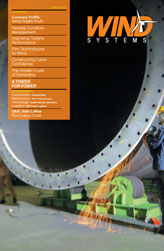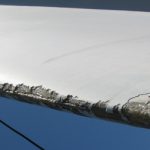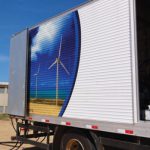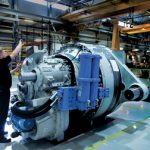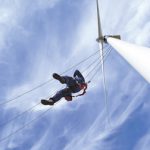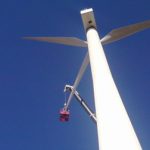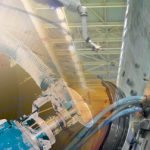Sliding electrical contacts used to transfer electrical signals or high current between two surfaces in relative motion can pose a significant maintenance burden. Traditional carbon- or graphite-based brushes used in most slip ring systems generate significant amounts of conductive wear debris, and the use of these brushes often results in electrical shorts to ground, reduced service life, susceptibility to contamination, low signal quality, restricted operating current, and the occasional fire. In the past there have been many unsuccessful attempts to solve these problems. Now, new military technology originally developed for the demanding needs of the U.S. Navy’s nuclear submarine fleet promises cleaner, longer-life brushes for wind turbine slip ring systems.
While many suppliers of “high performance” graphitic brushes add significant metal content to the brushes to improve the electrical performance, they are still burdened with the other known fundamental liabilities of carbon brushes. Some manufacturers have introduced what they term “metal fiber brushes.” These brushes are typically made from expensive gold alloy. These brushes address some of the shortcomings of carbon-based brushes, but since the fibers are oriented tangentially across the sliding surface and sequentially wear through the fibers in a transverse direction, they have relatively short service lives and are therefore not particularly suitable for high speed and high current applications.
Commercializing Military Technology
Since Navy submarines operate independently in remote regions and remain submerged for long periods of time, their electrical machinery demands high reliability with low maintenance. Several years ago the Navy teamed with the University of Virginia, HiPerCon, LLC, a Virginia small business, and DHi (Defense Holdings, Inc.) to develop a new electrical brush that could offer high reliability, longer life, and reduced wear debris having very low conductivity. The effort was successful and the new technology—a brush consisting of a bundle of thousands of very thin, flexible metal fibers (a “metal fiber brush”) running on their tips under very light spring pressure—is now being commercialized. What was originally developed for submarines is currently in use or under test in aircraft, power generation, shaft grounding, and other current transfer applications where clean, long-life power, and data transfer is important.
The patented tip-contact metal fiber brushes (MFBs, Figure 1) made by HiPerCon are much different from traditional monolithic carbon, silver-graphitic types of metal fiber brushes where the fibers make tangential contact. As might be imagined from the name, tip-contact MFBs run on their fiber tips.
Each brush contains thousands of hair-fine (50 micron) metal fibers that can flex so they stay in contact with the sliding surface (Figure 2“>). Since each fiber tip is in contact with the sliding surface there are literally thousands of contact points per brush, as opposed to monolithic carbon brushes where there might be between six and 12 contact spots at any given time. Since the carbon brush only makes contact at a few places, the brush is exposed to localized heating and higher wear at those locations. As these contact spots wear off the current is transferred to other contact spots, and then still others. This shifting of contact spots creates a significant amount of electrical noise and conductive wear debris. The hardness of carbon brushes also makes them susceptible to chattering and vibrations, which adds to the signal noise. Traditional carbon brushes don’t work well in a variety of conditions including very low or very high humidity, high runout where there are long periods of low or no current operation, or where they are required to sit for long periods of time with no current and no rotation. Tip-contact MFBs also avoid these problems.
Tip-contact MFBs can be made from copper, silver, gold, or other metals. The material selected for the fibers is based on sliding surface material, environmental conditions, and performance requirements. The fibers can be conditioned for extreme conditions such as <10 percent relative humidity or to inhibit oxidation of the sliding surface. Once conditioned by this patented process the fibers never need retreatment, eliminating the need to reapply brush lubricant during maintenance.
The specially-processed fibers in a tip-contact MFB are formed into a loosely-packed bundle. A brush is typically 1/6 fibers and 5/6 open space between the fibers. Since each fiber is in contact with the sliding surface and each fiber flexes with the sliding surface imperfections, very light spring forces can be used on the brushes. The fibers used in tip-contact MFBs do gradually wear, but because the spring pressure is so low that wear occurs very slowly. Typical MFB spring pressures are 20 percent of an equivalently sized carbon brush. Testing has shown that the wear particles produced resemble a microscopic curved oak leaf, and while the fibers themselves are highly conductive, tip-contact MFB wear debris is not particularly conductive unless the particles are compressed together tightly. As a result of all of these factors, tip-contact MFBs produce far less wear debris than competing carbon brushes, and the largely non-conductive debris causes far fewer problems and is easier to collect and remove.
With tip-contact MFBs, an outer wrap (Figure 3) retains the shape of the brush and can be made in nearly any shape or form factor. This outer wrap wears at the same rate as the internal fibers and can be made electrically conductive or insulating depending on the application. The stiffness and thickness of the wrap can be increased to handle severe vibration and runout conditions of up to 60 mils at sliding speeds of 20 meters/second.
Advantages of Tip-Contact MFBs
Service life: Since the fibers run on their tips (Figure 4) almost the complete fiber length is available for brush service, so in many cases brushes can be made longer if a longer service life is desired. Also, the very low spring pressures result in very low friction and correspondingly low brush and slip ring wear rates. Below are actual service life examples of HiPerCon’s tip-contact MFBs:
• A brush with 0.4” of fiber wear running on a coin silver 3” diameter slip ring will last 300M revolutions;
• A brush with 0.78” of fiber wear operating on a 3.5” diameter slip ring will last 400M revolutions;
• A brush with 1” of fiber wear running on a gold-plated 12” diameter slip ring will last 1.24B (1.24E9) revolutions;
• A brush with 2” of fiber wear operating as a grounding or potential energy brush running on a 1” carbon steel shaft will last 13.5B (1.35E10) revolutions.
Wear debris: Long brush service life reduces maintenance requirements only if the equipment using the brushes does not experience grounds as a result of brush wear debris from these longer-life brushes. It is counterproductive to develop a brush that can last forever if it produces so much conductive debris that maintenance personnel must frequently open, inspect, and clean the equipment to prevent grounds and shorts. Anyone who has ever worked on a carbon brushed slip ring assembly knows the burden of cleaning carbon brush debris. Figure 5 demonstrates the results of a comparison of the wear debris after 10M revolutions between a single silver-graphite brush on the left and a single HiPerCon tip-contact MFB on the right.
Electrical performance: HiPerCon’s MFB’s baseline capacity is 250 amps/inch2 of brush surface area, with 1000 amps/ inch2 possible under certain conditions. These high current capacities are achievable because there are thousands of contact spots in each brush and each contact spot has its own parallel current path through the brush. In fact, the limiting factor in the brush is generally not the brush itself, but rather the brush shunt. The data transfer capacity is also aided by these multiple contact spots. Instead of only a dozen contact spots, a HiPerCon tip-contact MFB measuring .25” X .25” has approximately 4,000 contact spots. This results in very low contact drop and very low noise. HiPerCon’s MFB’s typically exhibit an order of magnitude lower contact drop and noise compared to silver graphitic brushes.
Environmental performance: It would be nice if all carbon brushes could operate under pristine laboratory conditions, but the real world requires brushes to operate in less than ideal environments. Anyone who has replaced carbon brushes operating in an oily or hydrocarbon-filled environment will attest to the mess carbon brushes create. The oil breaks down the binder material used in monolithic carbon brushes, turning the once-solid and hard brush into a soft tar-like mess. MFBs are impervious to oily environments, and they don’t break down. Other atmosphere containments that destroy carbon brush films such as silicones and sodium chloride do not affect MFB operation.
Applications: Since tip-contact MFBs can be shaped like carbon brushes, they can be easily retrofitted to most carbon brush applications by simply reducing the spring force. HiPerCon MFBs have been retrofitted to replace carbon brushes in field excitation slip rings in Navy submarine motor-generators and for power and data transfer slip ring systems. Retrofit brushes have been designed for—but not yet deployed in—Army Black Hawk helicopter main rotor de-icing systems, E-2C & C-130 aircraft propeller de-icing systems, and hydro-electric generator excitation systems.
Wind Specifics
With its exclusive value-added reseller DHi, HiPerCon is presently introducing tip-contact MFBs for two applications of interest to the wind system community. These are: 1) brushes for wind turbine blade pitch control slip ring systems and; (2) shaft grounding brushes.
Blade pitch control slip rings: HiPerCon-DHi is offering blade pitch control slip ring systems with brushes designed to last 20 years. Since HiPerCon’s metal fiber brushes deposit so little wear debris and require no periodic lubrication, the slip ring service interval can be extended to five years and simply requires inspection and cleaning.
Grounding brush: This shaft grounding device (Figure 6) is a cost-effective means of preventing bearing damage as a result of stray shaft currents induced in shafts. This problem is particularly acute in variable frequency drive (VFD) motors. HiPerCon’s patented MFB technology allows it to offer a grounding brush system that can withstand severe operational environments with a very long life:
• Operates in oil-soaked environments;
• Service life in excess of 20 years or 1.8M miles of sliding distance at shaft speeds up to 20 meters/sec;
• Total system resistance when operating on an unconditioned bare steel shaft is ~3.7mΩ;
• One brush is capable of carrying 40 amps continuous current;
• Very small footprint and can be easily adapted to any motor or shaft with standard mounting options;
• Uses silver alloy fibers which are much less expensive than competitors’ gold fibers and can run directly on a steel shaft without shaft modification;
• Can easily be replaced during operation.
No shaft grounding system lasts forever, since any shaft grounding device must make contact with the rotating shaft to conduct current. The contact of two metals in relative motion always results in friction, and friction results in wear. These brushes, however, do have a long service life because they incorporate the very low wear rates of a light spring pressure metal fiber brush with very long fibers.



















